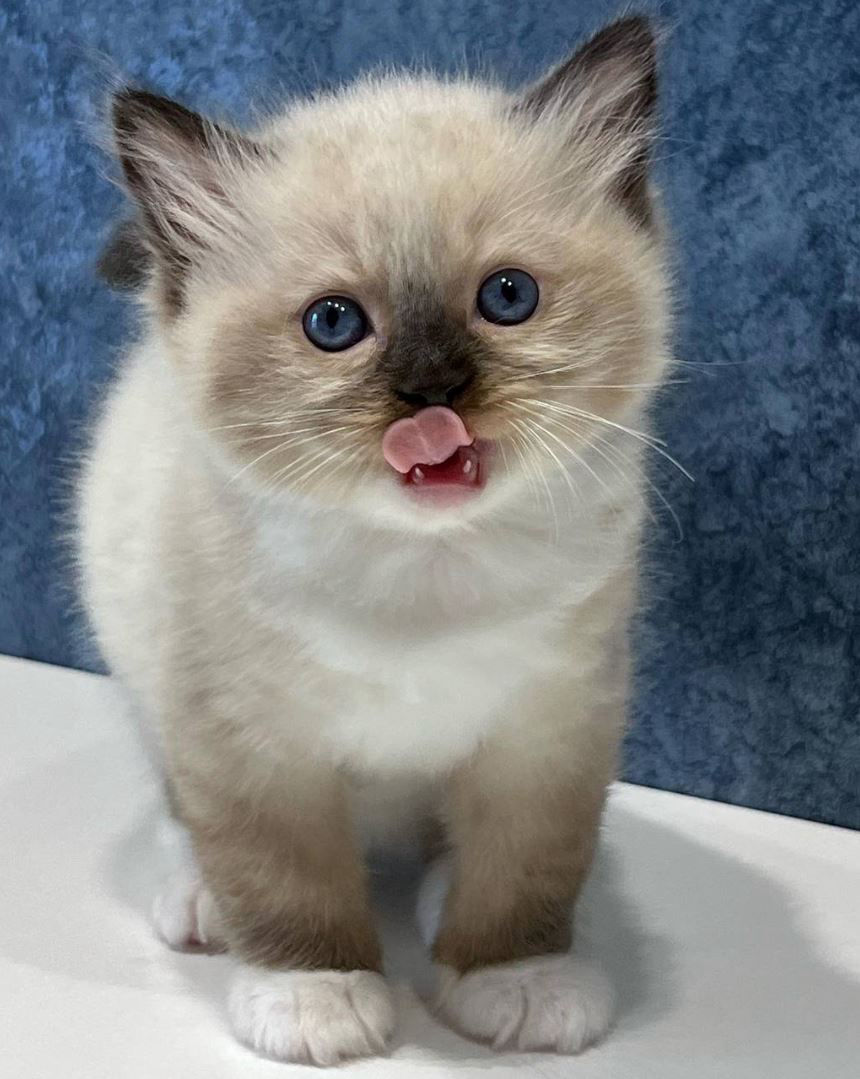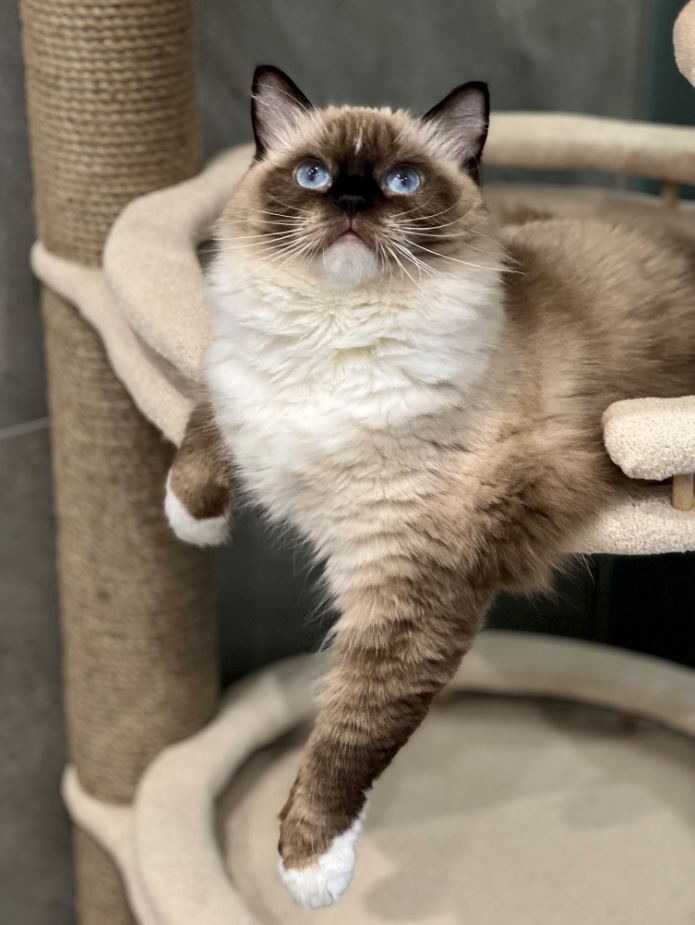О породе Рэгдолл


The history of ragdolls began in the 1960’s. It is full of mystifications and high-profile lawsuits. Ragdolls owe their existence to an enterprising lady from California Ann Baker, who bred Persian cats, as well as to Josephine, a long-haired beauty of mixed breed (presumably Persian and Angora), who lived with the breeder’s neighbor. Baker had been buying Josephine's kittens, many of which had unusually calm temperament. Later she used them to create a new breed.
Having become famous, the breeder stated in different interviews, that once Josephine was hit by a car and ended up in a hospital, where she was subjected to secret genetic experiments conducted by the CIA. Allegedly, due to this fact, kittens that she gave birth to after the accident, had peculiar qualities: hypomyotonia (reduced muscle tone), reduced pain threshold and remarkable calmness. There were incredible rumors, that ragdolls were of alien origin. It is not exactly known what lay at the basis of these stories – Ann Baker’s eccentricity or a marketing ploy of promotion specialists, however ragdolls do differ from other cats in terms of their physiology and temperament. According to the rationally thinking specialists, Josephine most likely possessed a peculiar combination of recessive genetic traits. Further on Ann Baker intentionally selected the calmest and most good-tempered cats for mating.
Creation of the new breed began from Josephine's offsprings that appeared after her mating with a Burmese cat, in whose coloring there were coal-grey colors. Continuing her selection work and wishing to “color” her pets in two other main colors – white and brown – Ann Baker added Burmese cats with dark brown marks to mating. It is unknown whether they were purebreds as the breeder didn’t record the first matings and she truly loved to experiment.
Ragdolls impress you with their beauty as well as their sizes. There are large and medium lines of ragdolls. In these lines male cats weigh up to 7-10 kg, and female cats up to 4.5-6.5 kg.
Classic color standards are allowed: colorpoint, mitted, bicolor. Each of them has 4 varieties: seal (dark brown), chocolate, blue, lilac.
Body
Ragdoll’s body is long, muscular, massive (especially in the back part). Chest – broad, protruding, neck – short, solid, bone – wide. At the same time their muscle tone is reduced, therefore the animal’s body is relaxed.
Legs
Moderately long, strong. Hind legs are a bit longer than the front ones. Paws are round, large and feather-tufted.
Head
Proportionately large in a form of a broad wedge with a flat plane between ears. Cheeks are well-developed and merge into a well-developed muzzle with jaws and a medium sized chin. Pedigree cats may have more developed cheeks. Nose has a light break, its length being two times bigger than its width.
Eyes
Oval, large, widely open. Moderately wide set. The eyes color of ragdolls depends on the lighting – from navy to bright blue.
Ears
Medium-sized, wide at base with rounded tips, sometimes may be adorned with tassels. Ears are a bit tilted forward.
Tail
Ragdoll’s tail is long, proportional to the body, gradually tapering towards the tip, wooly. A short, knotted tail is a fault of the breed.
Coat
Fluffy beauty! Moderately long, thick, soft fur. The coat is characterized by minimal woolly undercoat, so the coat does not stray into tangles. Short and moderately long on the front legs, medium and moderately long on the hind legs. Thick ruff around the neck. The fur length is shorter on shoulder blades, lengthening toward tail.
Towards winter ragdoll’s coat becomes even thicker. Pets that live in cold climate have longer fur.
Coloring
Ragdoll kittens are born completely white and by the age of 2 they obtain constant. With age colors become more vivid.
Colorpoint ragdolls have muzzles, ears, tails, lower part of shoulder blades of darker color than the main, lighter part of the body. Noses and paws are of the same dark tones.
Mitted color also implies a combination of a dominant light coat color and dark fragments. At the same time, cats have white “mittens” on their paws, a white stripe on the belly, chin and ruff of the same color.
Bicolor ragdolls also have dark patches, but on the muzzle the dark fur is combined with white, which lies between the eyes and cheeks and forms an inverted “V”. Legs are completely white. Nose and paws are pink. The “saddle” is of dark color.
In each type of coloring certain colors may be present. According to American standards there are 4 varieties:
Seal: the base color is “light tan”, patches are dark brown;
Chocolate; dominating color is ivory, patches are of milk chocolate
Blue: the base color is white, patches are dark grey;
Lilac: the base color is white, patches are pinky grey.
Large luxurious whiskers of ragdolls are always snow white.
The description of a ragdoll includes the color and the coloring name. for example, cats of a seal color are presented as seal colorpoint, seal mitted, seal bicolor.
Some European felinological association also acknowledge the following colors in ragdoll coloring: red, cream, tortie, tabby.
Ragdoll is an incredibly calm and friendly cat. It may seem lazy and phlegmatic, but it’s not like that, rather the state of its soul may be characterized by the word “tranquility”. Ragdoll feels special comfort whenever its master is close by. For this cat a master is the center of the universe. Ragdoll follows him or her everywhere and for this they got their nickname “doggy cat”, “puppy cat” or “cat-dog”. These cats love all the members of the family, they like to “talk’ to them caressing them with their meek deep gaze.
Ragdolls are playful, but not excessively so. They are extremely peace-loving and even naughty children who treat them like toys, carrying them around, can’t make them angry. In such cases cats are completely relaxed taking any poses depending on the playful kid’s fantasy. Most of the time they don’t feel any discomfort indeed, but sometimes they just express their patience in spite of the fact that such games maybe dangerous for them.
Ragdolls avoid conflicts, that’s why if they feel that there’s going to be a row, they hide waiting for the storm to pass.
They have a friendly attitude to other pets in the house. Even birds and fish do not provoke their predator instincts.
Ragdolls are vulnerable creatures with fragile soul organization. They shouldn’t be screamed at, because they may take it to heart and may fall into depression as well as loose appetite. These cats absolutely can’t endure loneliness and miss their masters, whose long absence may even cause the pet’s death. However, they will gladly travel with their owner: they easily accommodate to the change of living conditions, the main thing is for their master to be close.
Ragdolls are highly intelligent and have a good memory. They finely feel intonations, are quick to memorize their name and perfectly understand what their master wants from them. In fact, they don’t need special upbringing, delicacy is in their blood.
Purchase a scratching post for your pet: ragdolls like to sharpen their claws, however they rarely scrabble. Toilet train your cat since the early age. From the beginning use a bigger cat litter box considering the future size of the pet.
It would be useful to teach your pet to play with toys, this will help ease up the hours of solitude.
Ragdolls are neat and clean. That’s why their cat litter box should always be clean. As for grooming, it may be done even daily, they love it so much.
For the everyday grooming use a brush for semi-longhair and longhair cats. During shedding ragdolls should be groomed even more thoroughly: first use a small-tooth comb to groom the head and the breast, then continue to the neck and, back and sides, and finish with legs and belly, do not touch the tail. Continue the glossy session with a massage brush. As a finishing touch run your wet hands along all the length of the coat to remove any loose hair left. During the shedding you can use a furminator – a special device for grooming cats and dogs’ fur.
Ragdolls have excellent appetite, however, they are not obesigenic. These large cats should be fed abundantly, especially up to the age of 4 as they continue growing up to that age. Grown up pets are fed 2-3 times a day, kittens – up to 5 times.
Premium class ready-made cat food and natural food is suitable for feeding your purebred pet. Boiled meet such as beef, calf, rabbit and chicken as well as boiled sea fish is good for ragdolls. It is allowed to give eggs (raw and boiled) twice a week, especially to kittens. Boiled vegetables are obligatory in ragdolls’ diet. If your cat is being capricious, mix them with meat. Porridge (semolina, oatmeal, buckwheat, wheat) is also good in small amounts. Meat and vegetable components in food must have 2:1 proportion for grown up cats and 3:1 for kittens.
Salt, spices and sugar should be excluded from your cat’s diet. Milk is also not recommended, while sour cream or nonfat cottage cheese is allowed in your pet’s meals. Make sure the water bowl is not empty.
Ragdolls like to have a walk. They like to walk on a leash, but they like traveling in their master’s arms even more. These gentle trusting creatures should never be left unobserved outside. If a ragdoll gets lost, it won’t be able to find their way home. Most likely, the cat will hide and patiently wait till its master find it.
The choice of an authentic ragdoll is simplified by the fact, that it is not so complicated to define whether a kitten is purebred. Just take the kitten in your arms and if it hangs like a rag, that means you see a true representative of this unique breed. Nevertheless, make sure that the kitten has chubby cheek, pointed tail, ears rounded at tips and bright blue eyes.
The coloring of a kitten will not give you any information – all of them are completely white and do not differ from Burmese cats. Ragdolls’ color pattern starts to show very slowly and indistinctly, month after month. It will be fully established only when your pet reaches the age of 2.
Physical development of ragdoll kittens is somewhat slowed as well as the full maturation of the representatives of this breed. The eyes of the newborn kittens fully open only 2 weeks after they are born. The period of nursing with mother’s milk is longer than with other breeds. Although kittens are allowed to be sold when they are 2-3 months old, opt for a 4-months-old sturdy ragdoll kitten. By this time mother’s milk helps it to obtain immunity to various diseases, moreover, mother cat will have enough time to teach its baby the main useful skills and it will be easier for the kitten to accustom to a new habitat.
